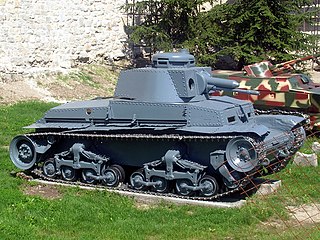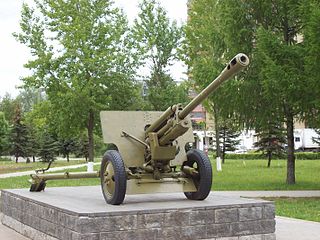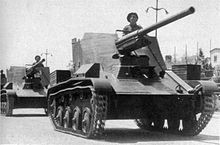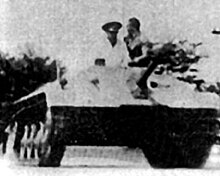
A tank destroyer, tank hunter or tank killer is a type of armoured fighting vehicle, predominantly intended for anti-tank duties. They are typically armed with a direct fire artillery gun, also known as a self-propelled anti-tank gun, or missile launcher, also called an anti-tank missile carrier. The vehicles are designed specifically to engage and destroy enemy tanks, often with limited operational capacities.

Self-propelled artillery is artillery equipped with its own propulsion system to move toward its firing position. Within the terminology are the self-propelled gun, self-propelled howitzer, self-propelled mortar, and self-propelled rocket artillery. They are high-mobility vehicles, usually based on continuous tracks carrying either a large field gun, howitzer, mortar, or some form of rocket/missile launcher. They are usually used for long-range indirect bombardment support on the battlefield.

The Kingdom of Romania was a constitutional monarchy that existed from 13 March (O.S.) / 25 March 1881 with the crowning of prince Karl of Hohenzollern-Sigmaringen as King Carol I, until 1947 with the abdication of King Michael I and the Romanian parliament's proclamation of the Romanian People's Republic.

The Panzerkampfwagen 35(t), commonly shortened to Panzer 35(t) or abbreviated as Pz.Kpfw. 35(t), was a Czechoslovak-designed light tank used mainly by Nazi Germany during World War II. The letter (t) stood for tschechisch (German for "Czech"). In Czechoslovak service, it had the formal designation Lehký tank vzor 35 (Light Tank Model 35), but was commonly referred to as the LT vz. 35 or LT-35.

The 76-mm divisional gun M1942 (ZiS-3) was a Soviet 76.2 mm divisional field gun used during World War II. ZiS was a factory designation and stood for Zavod imeni Stalina, the honorific title of Artillery Factory No. 92, which first constructed this gun.

The T-60 scout tank was a light tank produced by the Soviet Union from 1941 to 1942. During this period, 6,292 units were built. The tank was designed to replace the obsolete T-38 amphibious scout tank and saw action during World War II.

T-20 armored tractor Komsomolets(Bronirovannyy gusenichnyy tyagach Komsomolets T-20), an armored continuous track tractor, the T-20 was a prime mover vehicle used by the Soviet Union during the Winter War and World War II.

The T-34 medium tank is one of the most-produced and longest-lived tanks of all time.

The Mareșal, also known as the M-tank, was a Romanian-produced light tank destroyer from World War II. Romania was a member of the Axis powers and created the vehicle in response to the Soviet T-34 and KV-1 tanks. It is credited with having inspired the German Hetzer's design, according to multiple German military staff.

Raupenschlepper Ost was a fully tracked, lightweight vehicle used by the Wehrmacht in World War II. It was conceived in response to the poor performance of wheeled and half-tracked vehicles in the mud and snow during the Wehrmacht's first autumn and winter on the Soviet Front.

The TACAM R-2 was a Romanian tank destroyer used during World War II. It was built by removing the turret of the R-2 light tank and building a pedestal to mount a Soviet 76.2 mm (3.00 in) ZiS-3 field gun in its place. A three-sided fighting compartment was built to protect the gun and its crew. Twenty were built in 1944, but only one is known to exist today. It participated in the Budapest Offensive and the Prague Offensive.

Diplomatic relations between Germany and Romania began in 1880, when, following the Congress of Berlin, the German Empire recognized the independence of the Romanian United Principalities.

The 75 mm Reșița Model 1943 was an anti-tank gun produced by Romania during World War II. It combined features from the Soviet ZiS-3 field/anti-tank gun, the German PaK 40 and the Romanian 75 mm Vickers/Reșița Model 1936 anti-aircraft gun. It saw service against both the Soviets during the Jassy-Kishniev Offensive and against the Germans during the Budapest Offensive and subsequent operations to clear Austria and Czechoslovakia.

The TACAM T-60 was a Romanian tank destroyer used during World War II. It was built by removing the turret of captured Soviet T-60 light tanks and building a pedestal to mount a captured Soviet 76.2 mm (3.00 in) M-1936 F-22 field gun in its place. A three-sided fighting compartment was built to protect the gun and its crew. Thirty-four were built in 1943, and they served in the Jassy-Kishniev Offensive, and the Budapest Offensive.

The TACAM R-1 was a small tank destroyer used by Romania during World War II. It was designed on 22 November 1943 at the request of the Romanian General Staff. Fourteen R-1 vehicles were to be rearmed with 45 mm 20-K guns. Although this vehicle was designed to be used only for security duties, the project was cancelled because it was eventually regarded as a waste of badly needed industrial capacity, the 45 mm gun having been obsolete against most Soviet tanks by then such as the T-34 and KV-1.

The TACAM T-38 was a tank destroyer design proposed to be built in Romania during World War II. It was supposed to be a successor of the similar TACAM R-2, but never entered production.

The T-1 tractor was a project developed by the Romanian Army during World War II. A total of 1,000 were ordered. It was designed to tow a Romanian 75 mm gun. After five prototypes were produced, the project was canceled due to the lack of priority.
Southern Transylvania was a region of the Kingdom of Romania between 1940 and 1944, during World War II. The region of Transylvania, belonging entirely to Romania when the war started in 1939, was split in 1940 between Romania and Hungary, with the latter taking Northern Transylvania in the aftermath of the Second Vienna Award.
In 1942, a medium tank was proposed to be produced by the Axis-aligned Kingdom of Romania. The reason behind the proposal was the lack of a Romanian-produced armored fighting vehicle capable of challenging enemy Soviet tanks on the Eastern Front, as well as the allied Nazi Germany not being capable of supplying Romania with considerable amounts of tanks. The vehicle never saw production.

The R-1 was a Romanian-used tank that saw action during World War II within the mechanized Romanian cavalry. It was a modified version of the AH-IV, a Czechoslovak-designed export vehicle, which was used exclusively by Romanian forces during the war. A number of 36 were used, 35 of which were built in Czechoslovakia, while one modified example was built in Romania under license. The R-1 is classified as either a light tank or tankette.

























